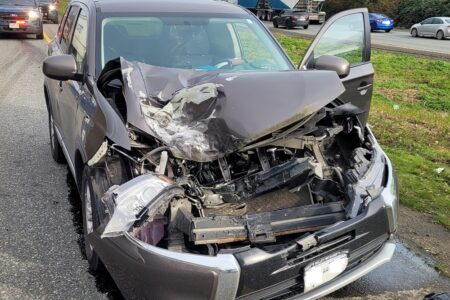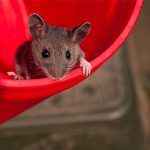Man rescues dog from black bear attack near New Denver
When Ralph Wilson saw his dogs being attacked by a black bear he didn’t hesitate.
The 47-year-old New Denver man had been walking up Carpenter Creek to go fishing with a friend on Thursday, Sept. 15 when he rounded a bend in the trail and saw the commotion.
Two of the three dogs were actively engaged with the bear — the bear’s jaws were locked on his border collie’s head — so Wilson gripped his fishing rod and dove in. He swung at the surprised bear and managed to draw its attention away from the dogs, but the bear did not let go of the collie.
Wilson dropped his fishing rod and wrapped his arm around the bear in a headlock and squeezed — and he received a bite for his effort. The quick wrestling move saved the dogs as the bear let go, and saved Wilson from a more serious bite (he received 14 stitches in his arm, a mangled watch and a leg scratch).
“It wasn’t the smartest thing to do, but you don’t think in those types of situations you just react,” he said Friday. “I thought my dog was dead and he would have been if I didn’t act.”
The situation could have been worse, said conservation officer Arnold DeBoon, sergeant for the entire West Kootenay region.
“His actions caused the bear to break off his fight and he was obviously successful in getting the bear and dogs apart,” he said.
The encounter happened around 12:20 p.m. about 15 minutes east of Union Street in New Denver, on a trail along Carpenter Creek. DeBoon said before Wilson left for New Denver Hospital for treatment, he noticed a small black bear cub in a tree nearby.
“This bear acted defensively when it saw the dogs … so it was defensive on its part to have bitten (Wilson) as well,” said DeBoon. “But she was acting as a bear would naturally in defence of its young. It’s not an unusual behaviour.”
Although there wasn’t much indication the bear had been on the trail for long — and was likely passing through — it was just the latest chapter in the ongoing saga of the bruin invasion in New Denver.
As one of the worst afflicted areas in the West Kootenay region for human-bear conflicts, DeBoon said there have already been eight bears trapped and destroyed this year in New Denver — more than anywhere else in the region.
Call it the battle of the Baby Boom Bruins, but a proliferation of bears in the Slocan Valley municipality could be tied to an abundant crop of huckleberries two years ago in the Kootenays, said DeBoon.
When sows go into their den for the winter in a healthy state with a good layer of fat, he said, they certainly can have more offspring than if they were in poor condition.
“Bear populations, as are other wildlife populations, are cyclical to food availability and that appears to be one of the contributing factors here,” he said.
An increase in bear population and a scarcity of berries in the upper reaches of the region due to a late spring has bear boomers looking in the valley bottom in search of food.
But local bear expert Wayne McCrory disagrees. He is currently finishing a Bear Smart study on the bruins for the upper Slocan Valley and, although he admits New Denver is a real problem area compared to other areas of the Slocan Valley — both rural and otherwise — there are other contributing factors to the bear epidemic.
New Denver has a much larger population of fruit trees than other areas, he said, greater than neighbouring Silverton where bear-human conflicts are almost non-existent. And with many absentee landowners, several wooded and creek travel corridors that come down into these highly nutritious food spots (orchards), and nearby viable black bear habitat, it’s a recipe for bear problems.
“So the bears aren’t in town because they are starving, that’s a myth; even during years of low huckleberry production,” McCrory said. “Bears aren’t starving. If that was the case we would all be overrun in many areas.”
Bears leave the huckleberry patches while they ripen in spring, said McCrory, come down for the cherries in June, and if they find it is pretty good they are going to stay in town for the summer. And they do. They hang in nearby wooded areas while other fruit ripens.
“Most people either tolerate the bears or avoid them, and they get feeling quite comfortable,” he said.
“If they don’t have that natural food in the interim they’ll switch to other foods, that are, in this case, more human produced foods than they would ordinarily go after,” DeBoon said.
The bear problem in New Denver is multi-layered, McCrory said. With so many fruit trees, all of the fruit cannot be picked from June to September in the village. A volunteer fruit-picking program can’t gather in all of that fruit before it entices bears down into the village.
And Bear Smart presentations made to the village and the community haven’t sunk in, he explained. He pointed to the irresponsible treatment of the village’s garbage as another attractant as people still haven’t become bear smart with their trash, putting it out the night before pickup in non-bear proof containers.
A bylaw in New Denver states that people are to place their garbage out the day of pickup and recommend freezing meat scraps until garbage day.
As well, the Province’s offloading of the Bear Smart program onto volunteer groups several years ago — like the Valhalla Wilderness Society — has meant the government’s role is relegated only to responding to complaints, and destroying the problem bears.
What is needed has to come from the provincial level, McCrory said. When bears first show up in town, they need to be trapped and removed long distances, instead of the short distance they currently are.
“So it would be an early treatment for the problem,” he said.
But constrained by shrinking budgets and only five field officers left to cover the entire West Kootenay, DeBoon said management has become complicated by a lack of time and resources.
“By the time we have to get involved with a trap, we are dealing with bears that are habituated and are a public safety risk. When they get to that stage we don’t relocate them. We trap them and destroy them,” he said.
“It’s been our experience, when they are relocated they will come back to that food source.”
The mother that attacked Wilson won’t be dealt with, said DeBoon, unless it becomes habituated and comes down into New Denver. From what he heard and conservation officers found in their investigation, he doesn’t believe the bear will be a problem.
But others will and are. At this time of the year the bears have a heightened desire to add calories before the winter, DeBoon said. And if people prefer to have tree-ripened fruit, it gives off an enticing odour to bears and they will find it — and the problem in New Denver will continue.
“We encourage people to pick the fruit now to remove the attractants,” he said. “But people may also have to accept this year that bears are going to be around and will get a large amount of their fruit, because, basically, that is what they are after.”
A few Bear Aware tips:
- Keep barbecues clean and inside campers, and use the bear-proof garbage containers.
- Pet food left out on the back porch, barbecues and bird feeders can be bear attractants. Remove the food and clean the barbecue.
- Pick up fruit from the ground underneath fruit trees, and pick any fruit still on the trees.
To contact a conservation officer, phone 1-877-952-7277.


























Comments